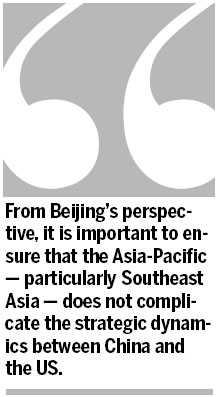For a new regional beginning
By Amitendu Palit (China Daily) Updated: 2013-10-10 07:24 With almost 40 percent of the global GDP and a quarter of global trade, the TPP is a sizeable economic bloc, and is expected to enlarge into a composite "Free Trade Area for the Asia-Pacific". The current composition and structure of the bloc indicates that other than economic motives, the TPP also serves the US foreign policy and security agenda of "balancing" China.
With almost 40 percent of the global GDP and a quarter of global trade, the TPP is a sizeable economic bloc, and is expected to enlarge into a composite "Free Trade Area for the Asia-Pacific". The current composition and structure of the bloc indicates that other than economic motives, the TPP also serves the US foreign policy and security agenda of "balancing" China.
The TPP's "binding" nature and excessive focus on achieving convergence in cross-country regulations has led to the emergence of parallel integration efforts such as the Regional Comprehensive Economic Partnership. China has been actively pursuing economic integration efforts in the region. Such efforts arising from within Asia have ASEAN centrality and develop as "ASEAN+" frameworks.
The RCEP is a grouping of ASEAN members and six other countries with which it has bilateral free trade agreements. It is negotiating in a more "non-binding" and voluntary fashion than the TPP and is expected to be sensitive to the situation prevailing in a country while promoting trade liberalization. Some ASEAN member states, such as Singapore, Malaysia, Brunei and Vietnam, are part of the TPP and RCEP both. A concern voiced by many is whether the TPP and RCEP will become competing strategic instruments between the US and China, and whether that might deepen the strategic rift within ASEAN.
China has always focused on strong economic relations as the best antidote for preventing bilateral political tension from becoming unmanageable. Its deep economic links with ASEAN, formalized through the China-ASEAN FTA, has facilitated the extensive growth of regional supply chains between Chinese and Southeast Asian producers and has kept tensions over South China Sea within manageable limits. President Xi's and Premier Li's visits to Southeast Asia and emphasis on trade and investment as the building blocs of China-ASEAN ties affirm the criticality of economics in China's external engagement policies.
As the China-ASEAN strategic partnership completes a decade, both sides realize the importance of the Asia-Pacific region in global affairs. The region will be a key area both for the US and China to exert greater strategic influence. This is inevitable given the narrowing strategic gap between the US and China and the importance of Asia-Pacific from trade, business and human and natural resource perspectives.
The world is closely following the developments in this regard and US President Barack Obama's decision not to attend the APEC leaders' meeting in Bali, Indonesia, because of domestic reasons is being seen as a strategic victory for China.
From Beijing's perspective, it is important to ensure that the Asia-Pacific - particularly Southeast Asia - does not complicate the strategic dynamics between China and the US. It must objectively negotiate at the RCEP and also consider the possibility of joining the TPP in future for maximizing economic and strategic benefits. It should also continue to focus on trade and economics to manage disputes in the South China Sea, which can be addressed through greater bilateral consultations.
And the visits of President Xi and Premier Li to Southeast Asia appear to be resonating this strategy of economic pragmatism and bilateral engagement.
The author is head of Partnerships & Programme and senior research fellow at the Institute of South Asian Studies in the National University of Singapore.
(China Daily 10/10/2013 page9)











